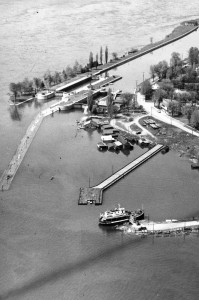This photo looks at the locks from upstream, the direction from which we come as divers on our long approach drift (15-18 minutes). Note that, although the depth of any river increases as we move away from shore, the tops of the walls here are all at the same height, quite close to that of the road (Canal Street) running alongside.
I’ve discussed in detail in this post how the depth of the road dictates the depth at which you approach your desired spot at the locks.
For simplicity’s sake however, I’ll outline arrival spot depths based upon present river levels which tend to run about one foot higher than last year.
On the photo, I’ve numbered the four unique wall features at the start of the locks.
- The very short, flat wall separating the Hydroelectric Plant sluice gates and the north wall of the Rapide Plat Lock. It is the only flat-faced wall that you can drift into head-on.
- The half-curved wall on the south side of the Rapide Plat Lock, even with the flat wall on the north side (1). It is the only half-curved wall on your approach.
- The humongous full-curved wall separating the Rapide Plat Lock and Lock 23. It looms large as you approach with significant current directly in front. It is the only curved wall on your approach.
- The vast south wall of Lock 23. It runs downstream to the end of the lock, and upstream all the way to the Tin Plate Factory Powerhouse. If at entry you swim south across the current, there is no way to avoid this wall. It’s high and gets higher (well, you actually get deeper) as you proceed along the locks.
For the past 2-3 weeks, the road has been recorded at 12 feet, sometimes a bit less. With this in mind, here are the drift depths to hit your desired arrival spot. They may not be absolutely accurate, given fluctuations, but they should be pretty close.
I’ve switched to my tabletop model because it’s a bit easier to see the details.

Remember that the river always carries or moves debris – be it sand, silt, bottles, pebbles, boulders, treasures. When flow encounters obstruction, all this stuff settles. The ends of the walls are such obstacles and have debris piles in front of them, the size of the debris pile dependent upon the size of the wall. Your challenge is to adapt to these as you get close since you’ll rise in the water and incorrectly believe that your depth has changed… and then miss your destination.
The walls also divide the flow – pushing you to the right or the left – another challenge.
Enjoy the ride. Learning to “read” the current, watch for the debris, and keep your depth stable is all part of the fun!
Sydney



